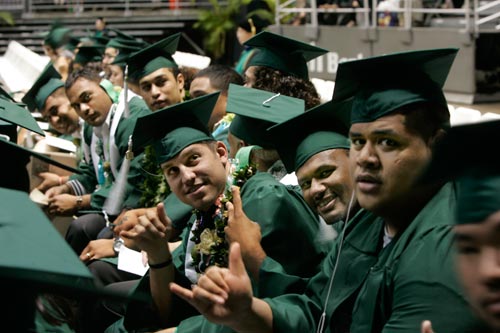UH ties funding request to goals

The University of Hawaii offers to tie a major funding request to goals that include boosting graduation rates.
The University of Hawaii will sweeten a legislative funding request to restore about $50 million in state cuts by making a portion of the appropriation contingent on meeting key outcomes.
By the numbersState general fund contributions to the UH system: » FY 2008-09: $468 million |
UH is proposing to tie $20 million of its operating budget request for the next two fiscal years to performance goals, including boosting how many degrees are conferred and the number of native Hawaiians in the system.
If appropriated, an additional $10 million will be set aside to cover a portion of the operating costs for new students — so the more new students enrolled, the more money UH gets.
The "incentive-based" budget, which comes in the wake of a painful round of cuts to the UH system, is aimed at driving reform and holding UH more accountable to ambitious goals it has included in its strategic plan.
Don't miss out on what's happening!
Stay in touch with breaking news, as it happens, conveniently in your email inbox. It's FREE!
"We’re now empowering the entire university to reward itself when it achieves its goals," said state Sen. Jill Tokuda, chairwoman of the Higher Education Committee. "What I’m excited about is how much we’ll be able to accomplish by incentivizing the campus."
Over the past two years, UH has seen the system’s operating fund appropriations shrink by more than $200 million, prompting UH campuses to cut adjunct faculty, reduce services such as library hours and slash outreach programs.
Under the budget plan, which will be presented to the Legislature in the upcoming session, about 5 percent of the university’s $409 million request for operating funds will be linked to performance goals.
The budget request represents a 14 percent increase from the appropriations UH got last legislative session.
UH is asking for an additional $49 million — $30 million of which will be tied to the enrollment or graduation outcomes. About $19 million is for program funding designed to boost graduation rates, attract more native Hawaiian students and meet other goals.
Howard Todo, UH chief financial officer, said he understands it will be a delicate balancing act to ask for more funding as the state is still facing tough financial times.
"It would not be appropriate in our minds to simply ask for our money back," Todo said, adding that the university "ought to live by" the goals it has set for itself and should be held to results.
Several state universities have already adopted similar performance-linked budgets, and more are coming on board at a time when there is increasing pressure to boost the number of college graduates nationwide and meet critical needs for doctors, teachers and professionals in the science, technology and engineering fields.
State lawmakers say they are excited about the new funding system, which came out of a new state law requiring UH to "develop an incentive and performance outcome funding component" to its budget.
And one legislator said incentives should be built into funding requests for other state departments.
The new budget is linked to the "graduation initiative" at UH, which aims to increase, by 25 percent in five years, the number of undergraduate, graduate and professional degrees conferred.
UH-Manoa has a graduation rate of about 54 percent, which is on par with peer institutions. About one-third of UH-Hilo students graduate within six years.
UH officials say graduation rates locally and nationally need to improve markedly if U.S. colleges are to meet the Obama administration’s goal of again having the highest proportion of college graduates in the world by 2020.
Hawaii is one of 23 member states in Complete College America, a partnership of colleges and universities working to bring college completion to the forefront of the nation’s agenda.
The performance budget is aimed at getting "people to move on what we think is important," said John Morton, vice president for UH community colleges, who is helping formulate the new budget system.
Morton said at first the outcome-based budget will tie 3 percent to 5 percent of the university’s state operating funds to performance outcomes.
That is not a make-or-break amount, but officials believe it will be enough to spur change and encourage growth.
The percentage linked to performance is expected to grow in future years, but officials do not yet know where it will be capped.
The Board of Regents unanimously approved the new budget last week at its monthly meeting, allowing UH to start talking to lawmakers about what the new performance budget will mean and how it will work.
Tokuda said the performance-based budget has been several years in the making.
The new budget ties funding over the next two fiscal years to five key goals:
» Increasing the number of degrees conferred systemwide annually by 8 percent, to 8,990
» Boosting the number of native Hawaiian undergraduates and graduates by 146 students in 2013, to 1,135
» Increasing the number of science, technology and engineering students by 6 percent, to 1,839
» Growing the system’s pool of Pell grant recipients, given for need, to 10,108 (an increase of 939 students)
» Increasing the number of transfers from community colleges by 10 percent, to 1,568 students
Each of the goals hold different weights — so meeting some goals will mean more money; others will have smaller incentives.
If UH reaches only some of the outcomes, it will get only a portion of the money. If it does not meet any of them, it will lose all of it.
"I think the university is taking a step in the right direction," said state Rep. Mark Nakashima, vice chairman of the Higher Education Committee. "The concept they’re using is a very good one. Instead of being a punitive thing, we work together to really better government."




